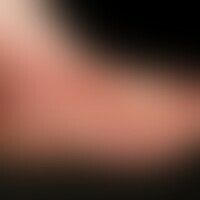Image diagnoses for "Skin defects (superficially, deep)", "red", "Leg/Foot"
48 results with 104 images

Artifacts L98.1

Lichen planus ulcerosus L43.8
Lichen (ruber) planus ulcerosus: extensive infestation of the feet with verrucous and crusty deposits and therapy-resistant deep ulcers with rough edges.

Pyoderma gangraenosum L88
Pyoderma gangraenosum. chronic progressive, painful, large-area, blue-reddish, slightly raised, approx. 5 x 4 cm large, ulcerated plaque with painful marginal zone and dark red-livid rim on the lower leg of a 36-year-old female patient with ulcerative colitis. on pressure emptying of pus and blood.

Arterial leg ulcer L98.4
Ulcus cruris arteriosum: very painful ulcer that has existed for about 1 year, is extremely resistant to therapy, sharply defined, as if punched out, and is known to have a history of smoking with PAVK.

Collagenosis reactive perforating L87.1

Rhagade R23.4
Rhagade: Recurrent, painful, deep, extremely schematic skin tear in the hyperkeratotic skin of the heel with underlying psoriasis plantaris, especially in the winter months.

Pyoderma gangraenosum L88

Prurigo simplex subacuta L28.2
Prurigo simplex subacuta: unusually extensive clinical picture with papules of different sizes, always centrally excoriated in a 51-year-old type I diabetic. severe, always punctual, prickly itching. ?spooning? of the lesion with the fingernail and then sudden cessation of the itching. involvement of the upper arm extensor sides, upper back, thigh extensor sides, chest region and face.

Pyoderma gangraenosum L88

Venous leg ulcer I83.0
Large circumferentialulcer of the lower leg and back of the foot in a patient with CVI after several split skin transplants.

Gaiter ulcer I83.0
Largeulcer of the left lower leg and back of the foot in a 63-year-old female patient with CVI known for 20 years after several split skin transplants.

Nodular vasculitis A18.4
Erythema induratum (Nodular vasculitis): The 48-year-old patient has been suffering for 2 years from these intermittent, moderately painful, therapy-resistant plaques which tend to ulceration.

Venous leg ulcer I83.0

Gaiter ulcer I83.0
gaiter ulcer. large, yellowish ulcer in the calf area in a 61-year-old female patient with lymphedema persisting for 25 years. after skin transplantation approx. 1.5 years ago, since then severe oozing and pain. distinct reddening of the periulcerous area. massive pain in the ulcerous area, indentable oedema.

Leg ulcer L97.x0
Ulcer cruris: Painful ulcer extending to the muscle fascia, with sharp edges and painful ulcer in necrobiosis lipoidica; bizarre vascular ectasia due to the atrophying underlying disease.

Fasciitis necrotizing M72.6
Fasciitis, necrotizing. foot of a 53-year-old patient. after a banal traumatic injury to the inner ankle, a fulminant, highly painful, doughy swelling developed within 3 days with diffuse redness of the entire lower leg. extensive necrosis of the skin of the inner ankle and over the edge of the tibia. fluctuating swelling in the middle of the lower leg. here incision with evacuation of about 50 ml of purulent secretion.

Nodular vasculitis A18.4
erythema induratum. solitary, chronically stationary, 4.0 x 3.0 cm in size, only imperceptibly growing, firm, moderately painful, reddish-brown, flatly raised, rough, scaly nodules with a deep-seated part (iceberg phenomenon). intermediate painful ulcer formation (Fig). no evidence of mycobacteriosis.

Malum perforans L98.4
Malum perforans: Sharply defined, sparsely documented ulcer in the area of the sole of the foot in the presence of polyneuropathy and microangiopathy in long-term known diabetes mellitus.






